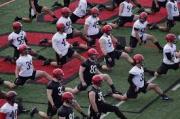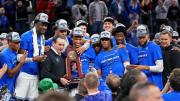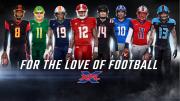Gene Therapy: NFL Scouting Combine 2022 | Speed Kills

by Gene Clemons
The moment we saw all of the receivers blazing fast times on day one of the on-field drills, we should not have been surprised by what we saw on the final day from the defensive backs. 13 prospects recorded sub 4.4 forties during the premiere drill of the combine. They wrapped up what will go down as one of the fastest NFL combines in history. But why?
There's curiosity behind these turbo-charged times. Why now? What made this year different? Is this an anomaly or is this a turning point in history? Will this result in a recalibration of what is considered a fast time? It used to be that a sub 4.5 marked elite speed, and those that recorded times below 4.4 were considered freaks of nature worthy of track and field consideration. 4.2’s that was flirting with all-time greatness, the Prime Time, CJ2K elite that would net you an immediate shoe contract.
This year a defensive end ran sub-4.4, that’s right, a defensive end!
Overall, three players broke into the 4.2’s. Baylor cornerback Kalon Barnes was the fastest man at the combine, recording a 4.23. 28 players ran faster than 4.4 seconds and 36 players crossed the laser in under 4.5 seconds. That’s 67 players who ran under a 4.5 forty. That’s more players who ran sub 4.4 than they did in 2021 and any other combine in the 21st century. But again, why? The interesting part of evaluation is that the forty is not the best drill to assess talent at the next level because it is only a straight-line drill. The three-cone drill and 20-yard shuttle are both much better drills to assess a prospect’s ability because they incorporate change of direction and acceleration. However, neither of those drills really show well on camera, they don’t do well with a simulcast. It is not easy for the laymen’s eye to decipher the difference between a good performance and a bad performance. At the end of the day, speed kills on the field and it sells off of it.
Preparing for the event
With the spotlight being shone on the forty-yard dash and teams proving that speed moves players up draft boards it is not surprising that more and more prospects are focusing less and less of their pre-draft workout on getting better at their craft and more time on being better at the 40. It has become its own competition with costly ramifications. Performance institutes seem to work on increasing explosion, stride length, form and leg drive. It seems to be working if we go by the numbers. More players are running faster times but at what cost?
Dane Brugler, draft analyst for The Athletic, tweeted that there were only two receivers that ran sub seven seconds in the three-cone drill; that’s compared to 23 in 2017. The steep fall off can be directly related to the effort expended training for the 40. They spend less time training their change of direction because they know many novices don’t pay attention to it and those numbers don’t seem to move the needle on draft day.
We also see more and more prospects cherry-picking their events and it is not surprising that we see so many draft hopefuls only complete the 40 and maybe one of the two explosion drills (vertical or broad). They want to put their best foot forward and then maybe double back to the other drills at their pro day. It is a smart strategy when it pays off but it does not answer questions like it used to. There was a time where the combine was stressful because it was a one shot deal, a place where everyone got to do everything at one time. With their film in hand and the information gathered from the combine, an evaluator would have all they needed to give an accurate assessment of a player's potential at the next level. It also showed the ability of the player to perform under stressful conditions. Now prospects are choosing to piece out their performances over several stops which might help them produce better numbers but does not answer any questions that may be there regarding their internal makeup. It definitely makes it more difficult on an evaluator who would rather see things with their own eyes instead of relying on just numbers.
Evaluations are blinded by speed
The fascination with speed has led to many teams missing on talented prospects because they fell in love with the speed of their contemporaries. In this draft University of Arkansas receiver Treylon Burkes was thought by many to be the top guy at the position. He ran a 4.55 40-yard time and people started backing off that prediction. It is funny because nothing about his football performance changed, he just ran a slower time than prognosticators believed he would. Because of that, many believe he has fallen below other receivers who have produced better times. That seems Counterproductive, especially when you consider the NFL player he has been compared to; Deebo Samuel.
Samuel ran a 4.48 forty at the combine in 2019 and received similar reactions. That caused him to drop out of the first round where he was projected to go. Marquise Brown and N’Keal Harry were both taken in the first round as Samuel draped into the second round and was chosen with the 36th overall pick. Samuel just finished an All Pro season for the 49ers and while neither Brown or Harry have been bad, they have not lived up to their draft status. AJ Brown and DK Metcalf were also taken late in the second round of that draft. So clearly there is no formula for a receiver that should be based on speed alone.
Every NFL Draft season mistakes are made because people get enamored with speed, at every position. Does it really matter that an offensive linemen ran sub five seconds on the forty, does that equate in any way to on-field success? The answer is no. But every year we marvel at those behemoths running items that used to be reserved for tight ends and linebackers.
Speed kills, and when people believe that you lack it, it can kill so much more.
###
Gene Clemons is a Sports Analyst and Contributor to CWN Sports. His weekly column and podcast - Gene Therapy focuses on Sports, Politics and Social/Urban issues.
Read more











